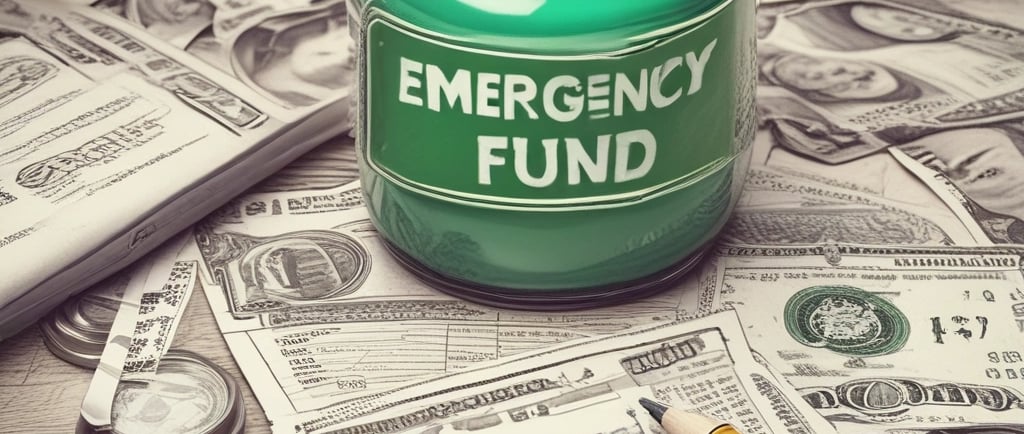How to Save for an Emergency Fund (And Why You Need One)
Learn why building an emergency fund is essential for financial security. Discover practical steps to save, how much to aim for, and tips to protect yourself from unexpected expenses.
9/25/20253 min read


If there's one financial goal everyone should prioritize, it’s building an emergency fund. Life is unpredictable — cars break down, jobs are lost, medical bills pop up, and home repairs don’t wait for payday. Having an emergency fund is like giving your future self a financial safety net.
So how do you build one, and why is it such a crucial part of your financial health? Let’s break it down.
What Is an Emergency Fund?
An emergency fund is a separate stash of money set aside specifically for unexpected expenses or emergencies. Think of it as your financial first-aid kit — not for vacations, not for shopping sprees, but for life’s “oh no” moments.
This fund helps you avoid turning to credit cards, personal loans, or dipping into long-term savings like retirement when the unexpected happens.
Why You Need One
Life Is Unpredictable
Emergencies are not a matter of if, but when. Whether it’s a sudden job loss, a medical emergency, or a major home repair, having funds set aside gives you peace of mind.Prevents You from Going into Debt
Without an emergency fund, most people rely on credit cards or loans, which come with high interest and long-term consequences. An emergency fund keeps you in control without needing to borrow.Protects Your Other Financial Goals
Without a cushion, a single emergency can wipe out your savings for a vacation, car, or even retirement. An emergency fund keeps your other goals on track.Reduces Stress and Anxiety
Money stress is real — and common. Knowing you have a financial buffer can ease your mind and help you sleep better at night.
How Much Should You Save?
This depends on your personal situation, but here’s a general rule of thumb:
Starter Fund: $500–$1,000 – a good goal if you're just beginning.
3 to 6 Months of Expenses: Once you're more financially stable, aim to save enough to cover three to six months of living expenses. This gives you breathing room in case of bigger disruptions, like losing your job.
If you’re self-employed or have an irregular income, you might want to save closer to 6–12 months of expenses.
How to Start Saving for an Emergency Fund
Set a Realistic Goal
Don’t aim too high too fast. Start with a small goal (e.g., $500), then work your way up. Every dollar counts.Open a Separate Savings Account
Keep your emergency fund separate from your regular checking account so you’re not tempted to dip into it. A high-yield savings account is a great option — it earns more interest and is still accessible.
To make tracking and staying consistent easier, I recommend using Clever Fox Budget Planner Expense Tracker Notebook. It has pages for savings goals, expense tracking, and emergency fund planning to help your progress stay visible and steady.
🟩 View on Amazon (affiliate link) — as an Amazon Associate, I earn from qualifying purchases.)
Automate Your Savings
Set up automatic transfers to your emergency fund every payday. Even $20–$50 a week adds up over time.Cut Back on Non-Essentials
Look at your spending habits and identify areas where you can temporarily cut back — eating out, subscriptions, or impulse buys — and redirect that money into your emergency fund.Use Windfalls Wisely
Tax refunds, bonuses, or cash gifts? Instead of spending them right away, consider putting a portion (or all) into your emergency fund.Track Your Progress
Seeing your fund grow is motivating! Use a visual tracker, spreadsheet, or an app to monitor your savings and stay on course.
When to Use Your Emergency Fund
Only tap into your emergency fund for true emergencies, like:
Job loss or income reduction
Major medical bills
Urgent car or home repairs
Unexpected travel for a family emergency
Try to rebuild it as soon as possible after you use it.
Final Thoughts: Start Small, Think Big
An emergency fund is one of the smartest financial moves you can make. It’s not about being paranoid — it’s about being prepared. You might not need it today, next week, or even next year, but when you do, you’ll be grateful you took the time to build it.
So start small, stay consistent, and treat your emergency fund like a non-negotiable part of your financial foundation. Your future self will thank you.
Disclaimer: This article is for informational purposes only and should not be considered financial advice. Always consult a licensed financial advisor for advice specific to your situation.
© 2025. All rights reserved.
